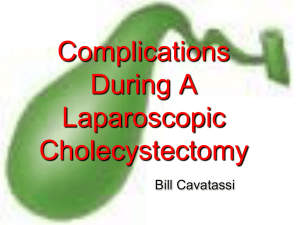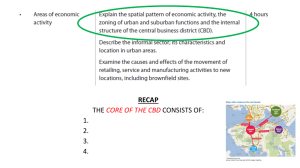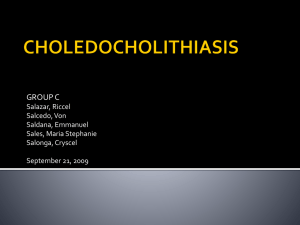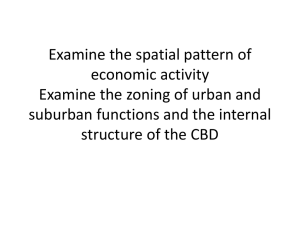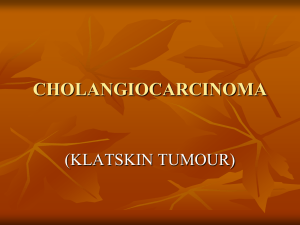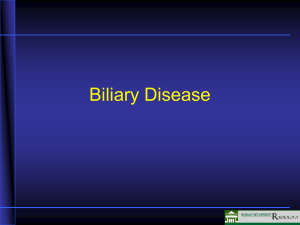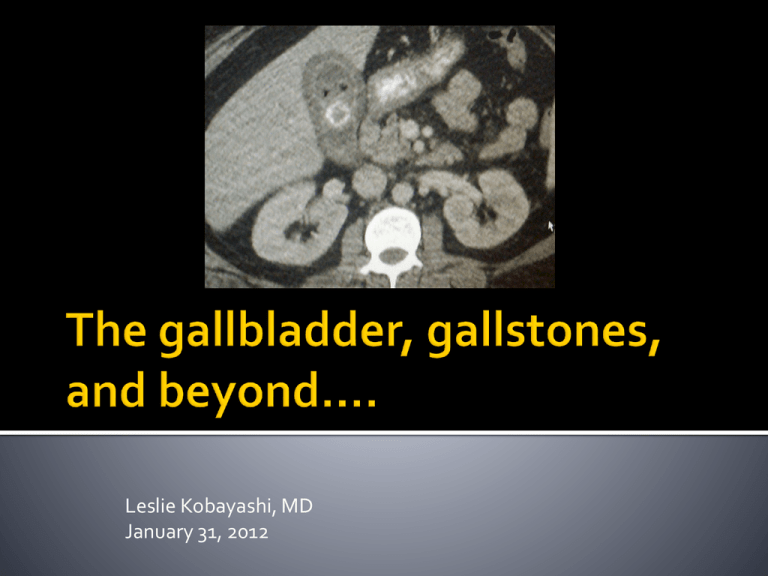
Leslie Kobayashi, MD
January 31, 2012
Liver
Bile ducts
Pancreas
Duodenum
Transverse colon
Fundus
Body
Infundibulum/Neck
Cystic duct
Spiral Valves of
Heister
Triangle of calot
Borders: CHD, cystic duct, liver edge
Contents: Cystic artery, node of Calot
Right and Left Hepatic ducts
Common Hepatic duct
Cystic duct
Common bile duct
Vascular
Normally (>90%)
cystic a. arises from
RHA
Replaced right
hepatic a.
Replaced left
hepatic a.
500-1500mL produced daily
Composition: water, electrolytes, bile salts,
proteins, lipids
Ductal epithelium products
▪ Alkaline phosphatase
▪ HCO3
Hepatocyte products
▪ Bile in conjugated soluble form synthesized from
cholesterol
▪ Primarily cholate and chenodeoxycholate
95% of bile re-absorbed into the liver via
portal vein (enterohepatic circulation)
85-90% in terminal ileum via active transport
10-15% deconjugated in colon, absorbed passively
5% excreted in stool
Cycles 6-10x daily
80% of bile stored in GB in
fasting state
Function store and concentrate bile
Absorption: NaCL, H2O occurs rapidly
Secretion: mucus, H+
GB average capacity 30-50mL
Can increase to 300mL with obstruction
Normal ejection 50-70% in 30-40min
Do gallbladder problems create a
significant healthcare
burden?
Health burden
6.2 Billion$ in US
1.8 million ambulatory care visits
Increased 20% since 1980’s
Cholecystectomy most common elective
abdominal procedure in the US
▪ 750,000 annually
Stones
Cholesterol stones (75%)
Female fat fertile
Black stones (20%)
Hemolytic diseases (Sickle cell disease)
Cirrhosis
*primarily form in the
Brown stones (5%)
ducts
Infection
PSC
Low calcium, radiolucent
Created when fractional cholesterol
content of bile increased, and with
incomplete emptying of GB
Associated with obesity, rapid weight
loss, Native American/Hispanic heritage,
↑TG’s, ↓HDL, Spinal cord injury
Hormonal influence
Estrogen increases lithogenicity of bile
▪ Increased risk for females
▪ Increased risk in obesity
Progesterone increases SM relaxation and
bile stasis, decrease bile salt secretion
▪ Increased risk in pregnancy
Increase risk of stone formation
TPN
Octreotide
Ceftriaxone
Decrease risk of stone formation
Statins
?ursodiol
Often radiopaque due to calcium
bilirubinate, calcium fatty acid soaps
and inorganic calcium salts
Two types
Black
Brown
Black
Form in GB
Bile sterile
Associated with age, hemolytic DO’s, alcoholism,
cirrhosis, Gilbert’s syndrome, Cystic fibrosis,
pancreatitis and TPN
Cholecystectomy curative
Brown
Form in ducts as well as GB
Always infected 1O with enteric organisms, often
associated with cholangitis
Associated with parasitic infection (liver fluke)
Associated with IBD, duodenal diverticulae
Will often recur after LC/OC
And what
do they do?
Stones
Asymptomatic
Symptomatic
Biliary
Uncomplicated
colic
Complicated
No obstruction
+ Obstruction
+
Cholecystitis
Infection/inflammation
GSP
CBD
Choledocho
- Infection
Ampulla
Cholangitis
+infection
Incidence: 10-30% of the population
Asymptomatic (80%)
Symptomatic (1-3% per year)
No inflammation: Biliary colic
+inflammation: acute cholecystitis
+obstruction : choledocholithiasis, GSP
+obstruction+inflammation: cholangitis
History
Transient abdominal pain
Occurs after fatty meals
Exam
Benign
Labs
Normal
Ultrasound
GS
Hyperechoic masses,
dependent in
location
Acoustic shadowing
History
Labs
Prolonged pain
Leukocytosis
Fevers
Mild ↑ LFT’s
Nausea/emesis
Exam
Imaging
Fever, tachycardia
Ultrasound
RUQ TTP, Murphy’s
HIDA
sign
Gallstones
Obstruction of gallbladder
Obstruction causes inflammation
Inflamed wall is thickened
Edema or emphysema of GBW
Inflammation may or may not be
associated with infection
50-70% of bile cultures are positive
E. coli, Klebsiella, Streptococcus,
Enterobacter
95% sensitivity/specificity
Signs of cholecystitis
Gallstones
GBW >3mm
Pericholecystic fluid
GBW striations or air within GBW
Sonographic Murphy’s sign
GS with GBW
thickening
Normal GBW <3mm
Pericholecystic
fluid
Cholescintigraphy: Injection of Tc99
labeled hydroxyl iminodiacetic acid
HIDA→hepatocytes→secreted into bile
Normal visualization of GB, CBD and SB
within 30-60 min
+scan if no visualization of GB within 1hr
and +uptake in CBD or SB
Normal HIDA
Positive HIDA
Rim sign
*Sphincter, ↙CBD
False positives common in fasting
patients
Up to 40-60% in critically ill
Can decrease false+ rate with morphine
↑sphincter of Oddi pressure causing
preferential filling of the GB
↑Tension in GBW =↓perfusion
→Necrosis of GBW
Gangrenous/emphysematous cholecystitis
▪ 1% of cases, 3:1 M>F
▪ Conversion rate 30-50%
GB Perforation
▪ Assoc with ↑mortality (~20%)
▪ Gallstone ileus
Cystic duct obstruction→ Hydrops
Bile is absorbed but GB mucosa
continues to secrete mucus
GB tense, filled with mucinous fluid
Mirrizi’s syndrome
Impacted stone in infundibulum or CD
→External compression of the CBD
0.7-1.4% of patients
Assc with ↑risk of
CBD
injury, GB cancer
Stone in CBD
No obstruction
Symptomatic
Asymptomatic
+ obstruction
No infection
+Infection
History: jaundice, icterus, pruritis, dark urine,
steatorrhea, acholic stools, bleeding
Exam: jaundice, icterus, RUQ pain, Murphy’s
sign
Labs
Elevated LFT’s, INR
Elevated bilirubin highest PPV 25-50%
May be normal in up to 30% of patients
Imaging
Dilated CBD on UTZ
▪ CBD <5mm risk of stone ~1%
▪ CBD >5mm risk of stone 58%
MRCP
Sensitivity 95%
Specificity 89%
CBD dilation
Stones within the bile
duct
History/Exam: similar to choledocholithiasis
with sepsis, septic shock
Labs/Imaging: similar to choledocholithiasis
with leukocytosis, bactermia, ±MSOF
Charcot’s triad RUQ pain, fevers, jaundice
Reynolds pentad Triad + ΔMS, shock
History: epigastric pain, nausea/emesis
Exam: RUQ/epigastric TTP, SIRS
Labs: amylase/lipase ↑3x nl, ±↑LFT’s,
leukocytosis
Imaging: ±CBD dilation, pancreatic edema,
necrosis, fluid collection
First 24hours:
48 hours
Glucose >200
Ca <8
Age >55
Hct↓>10
LDH>350
PaO2 <60
AST>250
BUN↑>5
WBC>16k
Base Deficit >4
Sequestration >6L
First 24hours:
48 hours
Glucose >220
Ca <8
Age >70
Hct↓>10
LDH>400
PaO2 <60
AST>440
BUN↑>2
WBC>18k
Base Deficit >5
Sequestration >6L
Each category 0 or 1
Add up total points
Mortality
0-2 <5%
3-4 15%
5-6 40%
7-8 ~100%
Medical
sphincterotomy,
Surgical
Lap
Open
CBDE
ERCP
stent
Percutaneous
Cholecystostomy
tube
Preparation
Eat a diet high in alkaline-forming foods and low in fats for at least 3-5
days before the cleanse.
Help to gently prepare the liver by having a glass of fresh apple juice
every day for 1 week prior to the cleanse. Apple juice helps to dissolve the
stones
Ingredients
•Epsom salts (Magnesium Sulfate): 4 tablespoons
•Olive oil: 1/2 cup or 125 ml
•Fresh pink grapefruit: squeeze 1/2 cup (125 ml) juice
•Or use 7-8 fresh lemons/limes: squeezed into 1/2 cup
•1 liter jar with lid
juice
Or you could try:
IVF hydration
Antibiotics
Bowel rest
Ursodiol: used as
Mechanism: supplemental bile acid decreases
lithogenicity of bile, dissolve existing stones
Indications: bridge to LC/OC, too sick for OR,
cirrhotics, PSC, TPN
Efficacy: may ↓LFT’s in PSC/cirrhotics, may
↓stones/sludge on UTZ, does not ↓symptoms,
prevent need for OR, stones recur after cessation
of medication
Diet:
Cholesterol/Fatty acids
Carbohydrates
Legumes
Unsaturated fats
Coffee, Fiber
Vitamin C, Alcohol
Failure of medical management in acute
cholecystitis 32%
Recurrence rate of GSP 29-63%
Surgical management results in reduced
HLOS
Timing of surgery for acute cholecystitis
Within 48hrs vs >72hrs no difference in
conversion rates, OR time, LOS
Comparing first hospitalization (<7d) vs
delayed (>6wks)
▪ 17.5% rqr emergent cholecystectomy for
recurrent/unresolving sx’s
▪ No difference in conversion rates or CBD injury
Timing of surgery for GSP
Early operation safe with mild
pancreatitis Rason’s criteria <3
Increased conversion rate, HLOS, and
operative complications in early
operation in severe pancreatitis
Ranson’s criteria ≥3
Port placement
Umbilicus
Subxiphoid just to the right of the falciform
at the level of the inferior liver edge
2-3cm below costal margin in midclavicular
line
Anterior axillary line, below the fundus of
gallbladder
Retraction and dissection of Triangle of
Calot prior to Gallbladder removal from
fossa
CD may be clipped, sutured, tied,
stapled
Remove gallbladder in fundus→dome
direction
Right subcostal incision
Mini-cholecystectomy (5-8cm) incision
associated with equivalent
outcomes/complications and less post-op
pain, decreased LOS
Dome down dissection technique
Isolate cystic artery/duct and suture ligate
Conversion rate: 0.18-35% ave 4.7%
CBD injury rates
Lap 0.2-0.6%
Open 0-0.3%
Complication rate
Lap ~1.2%
Open (bile leak 1%)
LOS: shorter for Lap
RF’s for conversion
Male sex
Obesity
↑age
Wide short cystic duct
Low surgeon case load
Gangrenous or emphysematous chole
↑risk of conversion RR 3.2 (CI 2.5-4.2)
No ↑risk of local complications or CBD injury
Can be transhepatic or transperitoneal no
difference in outcomes
Technical success 96-98%
Resolution of symptoms 68-96%
Mortality 3-14%
Complications
Dislodged catheter 16-33%
Bleeding 1.5-1.8%
Recurrent cholecystitis 7-41%
Choledocholithiasis
Stones in CBD in 10-15% of symptomatic pt’s
55-70% pass spontaneously
GSP20-30% of patients have CBD stones
85-90% pass spontaneously
Symptomatic cholecystitis
4.6% +IOC at the time of LC
97.8% pass spontaneously
CBDE
Can be performed
lap or open
Transcystic or via
choledochotomy
CBDE
Imaging duct
▪ Fluorscopic guidance
▪ Choledochoscopy
Clearing duct
▪ Basket, snare, flush
▪ +/- glucagon to relax sphincter
CBDE
Completion cholangiogram
Clip, tie or staple cystic duct stump
Close choledochotomy over T-tube
+/-drain external
Success rate of duct clearance 75-95%
Efficacy
1 procedure: 71-75%
Multiple procedures: 84-95%
Mortality 0.2-0.5%
Complication rate 5-8%
Perforation
Bleeding
Pancreatitis
Cholangitis
1-2% of patients will represent with
CBD stone following
cholecystectomy
Dx <2yrs post-op = retained stone
Dx > 2yrs post-op =recurrent stone
Ileus
Incisional/port site hernia
Wound infection
Abscess
Biloma/bile leak
Strasberg-Bismuth
classification
A-CD stump, fossa
B/C-aberrant RHD
D-lateral injury
E-circumferential
injury to major duct
Increased risk of stones
2-12% have stones
0.05-1.2% symptomatic during pregnancy
Risk of stones increased in:
Hispanic
Pre-pregnancy obesity (4x)
Decreased by EtOH consumption
Biliary disease the most common nonobstetrical cause of maternal
hospitalization
Cholecystitis most common 40%
GSP 30%
CBD stone 20%
Biliary colic 10%
If symptomatic risk of recurrence
high
40%-70% recur prior to delivery
If symptomatic risk of fetal loss high
10-20%
Treatment goals
Treat infection
Maintain nutrition
Prevent contractions/preterm labor
Prevent fetal loss
Prevent maternal morbidity/mortality
Surgical management associated with
fewer complications than medical
management
Contractions equivalent (~30%)
Decreased preterm delivery, need for c-
section, and recurrent symptoms
Fetal loss with LC 0-5%
Ideal timing LC/OC 2nd trimester
↓preterm labor (0% vs. 40%)
↓ fetal loss
↓ risk of fetal malformation
Technically easier
1st delay to 2nd, 3rd delay to
postpartum
ERCP can be performed safely with:
Low radiation exposure
▪ Fluoro time 14sec-3.2min
▪ Radiation exposure 40-310 mrad
Few complications ~7%
Operative considerations
Port placement to accommodate
uterus
Hassan vs. Veress likely equivalent
↓insufflation pressure 10-12
Stones more common in cirrhotics (2x)
Diagnosis difficult
Pain nonspecific
Elevated LFT’s nonspecific
Leukocytosis nonspecific
GBW thickening nonspecific
▪ HIDA may be helpful
Management differences
Increased operative risk
▪ Morbidity 3x
▪ Conversion 2x
▪ Bleeding 8x
Increased risk with cholecystostomy
▪ Bleeding
▪ Ascites/Leak
Mortality
Overall acceptable 0.6-0.8%
Significantly increased in Child’s C patients (17%)
LC safer than OC
Less bleeding
Shorter OR time
Shorter HLOS
Possibly lower mortality (open mortality 8-25%)
Acalculous cholecystitis
M>F 1.5:1
4-8% of all cholecystitis
Dx with UTZ/HIDA
Gallbladder polyps
Gallbladder cancer

